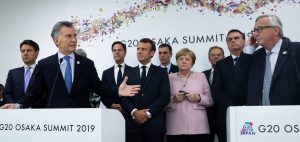The military dictatorships installed in the southern cone during the second half of the 20th century, in contrast to historical fascism in Europe, were characterized by following to the letter the plans marked by the USA, especially in economic matters. Thus, while Washington’s think-thanks theorized how far to go with the «thinning of the State», the peoples of Latin America suffered from the executing arm of Pinochet, Videla, Stroessner and company. While the dictatorships disappeared thousands of people, millions of workers saw how their living conditions drastically diminished.
This set up neoliberal dynamics that were difficult to reverse, which left the Latin American economies with the enormous slab of indebtedness and the privatization of strategic sectors. After the exit of the dictatorships and the restitution of the bourgeois democracies, both in Argentina and Brazil liberal options arrived at the government that at no time did they have the will to change the direction of the economy. In addition, both countries, as a consequence of previous policies, faced serious economic crises aggravated by hyperinflation. As a curious fact, in Alfonsín’s Argentina, the inflation problem was so big that supermarkets closed several times a day in order to change prices. In this context of absolute economic disaster and the difficulty of obtaining external credit is when the first economic rapprochement and agreements between the government of Brazil and Argentina begin to take place. The first milestone was the Declaration of Foz do Iguaçu in 1985, considered the cornerstone of Mercosur. After this, in 1988 the Alvorada Act was signed, by which Uruguay joined the «integration process» and in 1991 the Treaty of Asunción which, besides incorporating Paraguay, adopted for the first time the name MERCOSUR and created a free trade zone.
MERCOSUR was born, therefore, under the false premise of being a tool for regional integration but with a clear roadmap to follow the neoliberal plans to create free trade areas. At the same time, in the north, the United States, Canada and Mexico signed NAFTA, which gives a good example of the common agenda of capital. And on this side of the pond? Here we had already been developing the EU for years and, by that time, the Maastricht Agreement was responsible for unifying and synthesizing the treaties drawn up so far (Treaty establishing the European Coal and Steel Community, the Treaty establishing the European Atomic Energy Community and the Treaty establishing the European Economic Community).
The table was served and, when many Latin American countries were heading towards the bicentenary of their first independence, the puppet governments of the oligarchy were in charge of moving a little further away the horizon of the second and definitive one.
In 1995, the MERCOSUR-EU Framework Cooperation Agreement was signed, drawing the yearning that bourgeois from both continents celebrate today.
However, in times when more defeats than springs flourish, we must go back over history and ask ourselves why more than twenty years have had to pass for the announcement of the final agreement. If we said that, in Latin America, the 80s were the years of crisis and hyperinflation, the 90s were a kind of deadly blow to the working classes.
From Washington’s recipes to the genocidal, we passed on to presidents like Ménem, erected at the forefront of the World Bank and the International Monetary Fund. In Argentina, what remained to be privatized was privatized, so as to reach points as ridiculous as seeing traffic lights adorned with advertising.
In addition, the total liberalization of the market resulted in the destruction of national industries. From the collective trauma, and without the intention of falling into simplisms, the political proposals that mark the Latin American agenda during the first decade of the 21st century are nourished: the K in Argentina, Lula in Brazil, chavismo in Venezuela, the Frente Amplio in Uruguay and Lugo in Paraguay. Apart from the enormous differences between each of the projects, a common denominator is undeniable: the will of a Latin American integration process that had little to do with what has been traced so far.
Bush was able to give good faith of this in Argentina in 2005 when the IV Summit of the Americas went from being the starting point of the Free Trade Area of the Americas (FTAA) to the final point. There Chávez proclaims: «FTAA, FTAA… Fuck it», Néstor Kirchner, Maradona and an Evo Morales, who was a presidential candidate, smile; while a stadium full of people celebrates and gives life to the Great Homeland. More than FTAA, in Latin America there was talk of ALBA.
Unfortunately, the Latin American map, with all its limitations, has changed a lot and now has a lot more to do with what the 80s and 90s were. The two largest economies of MERCOSUR (Brazil and Argentina) have at the front governments that underwrite the return to formulas of delivery (sale of the country), adjustment (cuts on the popular sectors) and repression. Macri (who in a few weeks faces elections that are not very promising for him) and Bolsonaro are also experiencing a sharp drop in their popularity and find in the MERCOSUR-EU Agreement an excuse to sell smoke to their people. For its part, Europe sees in the present moment its opportunity to strengthen itself in the face of the US-China economic war and to tiptoe over the Brexit crisis. If Milton Friedman were to rise from his grave (which is absolutely unnecessary) he would be far more proud of the EU than of his beloved United States of America.
Who has the upper hand with this agreement? Of course, the popular layers on both sides of the Atlantic do not. In 2018, 70% of MERCOSUR exports to the EU were primary products. If the primary sector is not going through its best moment in Europe, how is it going to cope with the elimination of tariffs on MERCOSUR products? And no less important, how much will the prices of these products soar on the shelves of Latin American supermarkets?
The centre-periphery relationship is strengthened when, on the other side of the trade balance, what the EU exports to MERCOSUR are, above all, goods with high added value. The little industrial fabric that survived neoliberalism, which, incidentally, was not sufficiently strengthened by the so-called popular governments, has a totally desolate panorama ahead of it.
Nor can we fail to put this agreement into context within the great global resource crisis: Latin America has fossil fuels but also a large part of the world’s largest freshwater reserves. Furthermore, strengthening the EU as MERCOSUR’s main trading partner is a clever way to isolate Venezuela and aggravate the country’s economic crisis.
Marxism has given us the ability to find in the international division of labour one of the characteristics of imperialism. Today, with the direction that EU-MERCOSUR relations are taking, we see how the roles that have generated so much inequality in the world are being reinforced. All signs of a sovereign Great Homeland seem to be buried under the return to the agro-export model and dependence. Any possibility of change in the European Union sounds illusory again. By eliminating tariffs, the EU not only becomes the great bulwark of free trade (and its consequences), but also transfers billions of public euros to private companies. The benefits, of course, will go to others.
For us it may be to see our oceans collapse further with increased maritime traffic or weep for an Amazon that burns to fill the same pockets that are filled with our labour force. Let no one be alarmed if our agreement is to collapse or burn the streets, we need it more than ever.

